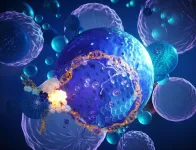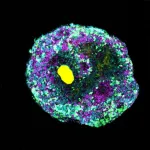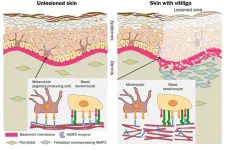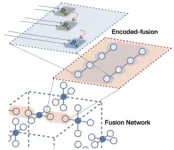(Press-News.org) The lead article in the current issue of The Criminologist, written by Nancy Rodriguez, University of California Irvine professor of criminology, law and society, shines a light on the lack of prison violence metrics that could help advance safety.
“For the 800,000 persons currently confined and the 200,000 state and federal correctional officers who work within U.S. prisons, the threat of violence is a routine feature of daily life,” she writes. “Accounts from incarcerated persons and staff detail the ever-present threats to safety in prisons and the human toll of this violence.”
Federal resources have been dedicated to improving the conditions of confinement and addressing the diverse factors that contribute to safety, including mental health, substance use, and contraband detection, Rodriguez notes.
But, improvement is slow-going, she says.
“Despite the detrimental consequences of violence in correctional institutions, we remain woefully ill-equipped to determine whether institutions are becoming safer or more dangerous,” the professor writes. “Institutional violence cuts through every dimension of the incarceration experience. It disrupts prison operations and practices, including those designed to improve correctional outcomes and well-being. … Programming, treatment services, timely medical care, and recreation time are unavailable during prison lockdowns, while suspensions of visitation restrict access to loved ones. Consequences of violence continue upon release, where managing the trauma associated with prison violence compounds an already challenging reentry process, with likely impacts on recidivism and well-being. Yet, current correctional policy has not explicitly targeted violence prevention and intervention.”
Rodriguez, who served as director of the National Institute of Justice from 2015-2017, has been studying prison violence for years and stresses the need for consistent data to monitor, track, and compare violence across state and federal prisons. In order to advance safety in prisons, she calls on the U.S. Department of Justice to create a national, uniform measure of prison violence.
She wants the DOJ to “to build on recent efforts to expand accountability and transparency and to develop a mechanism to improve the safety of everyone within state and local facilities. Anything less will be detrimental and seen by many of us as performative posturing.”
Articles/essays published in The Criminologist are reviewed by its editor and associate editor.
Read the full article
END
Advancing prison safety
Why metrics matter for correctional policy
2024-09-10
ELSE PRESS RELEASES FROM THIS DATE:
Towards a better understanding of epigenetics and dynamic gene silencing and reactivation
2024-09-10
Ikoma, Japan – One of the most fascinating discoveries in biology is that cells have mechanisms for dynamically regulating genetic expression. This ability to promote or restrict the transcription of specific genes without altering the DNA sequences themselves is essential to all forms of life, from single-cell organisms to the most complex plants and animal species.
While our understanding of these so-called epigenetic mechanisms is far from complete, remarkable progress has been made in this field with the understanding of the role of the Polycomb Repressive Complex 2 (PRC2). PRC2 is a protein that, in many plants, binds to specific DNA sequences called polycomb ...
Artificial muscles propel a robotic leg to walk and jump
2024-09-09
Inventors and researchers have been developing robots for almost 70 years. To date, all the machines they have built – whether for factories or elsewhere – have had one thing in common: they are powered by motors, a technology that is already 200 years old. Even walking robots feature arms and legs that are powered by motors, not by muscles as in humans and animals. This in part suggests why they lack the mobility and adaptability of living creatures.
A new muscle-powered robotic leg is not only more energy efficient than a conventional one, it can also perform high jumps and fast movements as well as detect and react to obstacles – ...
Researchers develop reaction-induced molybdenum carbides for efficient carbon dioxide conversion
2024-09-09
Molybdenum (Mo) carbides, known for their unique electronic and structural properties, are considered promising alternatives to noble metal catalysts in heterogeneous catalysis. However, traditional methods for preparing Mo carbides suffer from complex processes, stringent synthesis conditions, challenging crystal regulation, and high energy consumption. Additionally, Mo carbides are susceptible to oxidation and deactivation, which poses a significant barrier to their widespread application.
In a study published in Nature Chemistry, a research group led by Prof. SUN Jian from the Dalian Institute ...
Researchers identify factor that drives prostate cancer-causing genes
2024-09-09
For more information, contact:
Nicole Fawcett, nfawcett@umich.edu
EMBARGOED for release at 5 a.m. ET Sept. 9, 2024
Researchers identify factor that drives prostate cancer-causing genes
Factor previously known to play a role in advanced cancer is fundamental in early stages of cancer development
ANN ARBOR, Michigan — Researchers at the University of Michigan Health Rogel Cancer Center have uncovered a key reason why a typically normal protein goes awry and fuels ...
New molecular engineering technique allows for complex organoids
2024-09-09
A new molecular engineering technique can precisely influence the development of organoids. Microbeads made of specifically folded DNA are used to release growth factors or other signal molecules inside the tissue structures. This gives rise to considerably more complex organoids that imitate the respective tissues much better and have a more realistic cell mix than before. An interdisciplinary research team from the Cluster of Excellence “3D Matter Made to Order” with researchers based at the Centre for Organismal Studies and the Center ...
How the brain's inner chamber governs our state of consciousness
2024-09-09
In hospital operating rooms and intensive care units, propofol is a drug of choice, widely used to sedate patients for their comfort or render them fully unconscious for invasive procedures.
Propofol works quickly and is tolerated well by most patients when administered by an anesthesiologist. But what is happening inside the brain when patients are put under and what does this reveal about consciousness itself?
Investigators at U-M who are studying the nature of consciousness have successfully used the drug to identify the intricate brain geometry behind the unconscious state, offering an unprecedented ...
Can coping with a cancer diagnosis contribute to psychological and cardiovascular problems in family members?
2024-09-09
New research suggests that a family member’s cancer diagnosis may increase first-degree relatives’ and spouses’ risks of developing psychological and cardiovascular illnesses. The findings are published by Wiley online in CANCER, a peer-reviewed journal of the American Cancer Society.
Having a family member diagnosed with cancer can be a stressful and traumatic experience for the entire family. Because stress influences not only mental health but also cardiovascular health, investigators explored whether a cancer diagnosis contributes ...
Loss of skin’s pigment-producing cells could be related to basement membrane disruption
2024-09-09
Skin pigmentation disorders affect people across the world. One of them, vitiligo, is said to have a worldwide incidence of 1-2%. What causes the loss of pigmentation in vitiligo has long been unclear, but an Osaka Metropolitan University-led team has uncovered clues to the mechanism behind the disorder.
In findings published in The Journal of Pathology, Graduate School of Medicine Specially Appointed Associate Professor Lingli Yang, the corresponding author, and researchers including Specially Appointed Professor Ichiro ...
Developed proprietary quantum error correction technology beyond the world's leading quantum computing companies
2024-09-09
Solving the problem of error is essential for the practical application of quantum computing technologies that surpass the performance of digital computers. Information input into a qubit, the smallest unit of quantum computation, is quickly lost and error-prone. No matter how much we mitigate errors and improve the accuracy of qubit control, as the system size and computation scale increase, errors accumulate and algorithms become impossible to perform. Quantum error correction is a way to solve this problem. As the race for global supremacy in quantum technology intensifies, most major companies and research groups leading the development of quantum ...
AI will surpass human brains once we crack the ‘neural code’
2024-09-09
Humans will build Artificial Intelligence (AI) which surpasses our own capabilities once we crack the ‘neural code’, says an AI technology analyst.
Eitan Michael Azoff, a specialist in AI analysis, argues that humans are set to engineer superior intelligence with greater capacity and speed than our own brains.
What will unlock this leap in capability is understanding the ‘neural code’, he explains. That’s how the human brain encodes sensory information, and how it ...
LAST 30 PRESS RELEASES:
Society for Laboratory Automation and Screening welcomes new scientific director: Madeline M. Farley, Ph.D.
Austrian cow shows first case of flexible, multi-purpose tool use in cattle
Human nasal passages defend against the common cold and help determine how sick we get
Research alert: Spreading drug costs over the year may ease financial burden for Medicare cancer patients
Hospital partnership improves follow up scans, decreases long term risk after aortic repair
Layered hydrogen silicane for safe, lightweight, and energy-efficient hydrogen carrier
Observing positronium beam as a quantum matter wave for the first time
IEEE study investigates the effects of pointing error on quantum key distribution systems
Analyzing submerged fault structures to predict future earthquakes in Türkiye
Quantum ‘alchemy’ made feasible with excitons
‘Revoice’ device gives stroke patients their voice back
USF-led study: AI helps reveal global surge in floating algae
New method predicts asthma attacks up to five years in advance
Researchers publish first ever structural engineering manual for bamboo
National poll: Less than half of parents say swearing is never OK for kids
Decades of suffering: Long-term mental health outcomes of Kurdish chemical gas attacks
Interactional dynamics of self-assessment and advice in peer reflection on microteaching
When aging affects the young: Revealing the weight of caregiving on teenagers
Can Canada’s health systems handle increased demand during FIFA World Cup?
Autistic and non-autistic faces may “speak a different language” when expressing emotion
No clear evidence that cannabis-based medicines relieve chronic nerve pain
Pioneering second-order nonlinear vibrational nanoscopy for interfacial molecular systems beyond the diffraction limit
Bottleneck in hydrogen distribution jeopardises billions in clean energy
Lung cancer death rates among women in Europe are finally levelling off
Scientists trace microplastics in fertilizer from fields to the beach
The Lancet Obstetrics, Gynecology, & Women’s Health: Taking paracetamol during pregnancy does not increase risk of autism, ADHD or intellectual disabilities, confirms new gold-standard evidence review
Taking paracetamol during pregnancy does not increase risk of autism, ADHD or intellectual disabilities
Harm reduction vending machines in New York State expand access to overdose treatment and drug test strips, UB studies confirm
University of Phoenix releases white paper on Credit for Prior Learning as a catalyst for internal mobility and retention
Canada losing track of salmon health as climate and industrial threats mount
[Press-News.org] Advancing prison safetyWhy metrics matter for correctional policy







